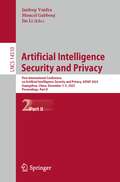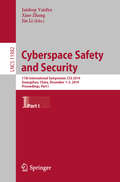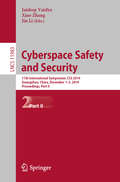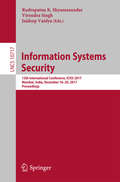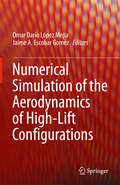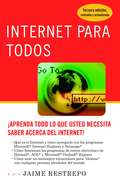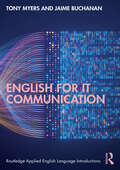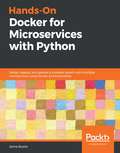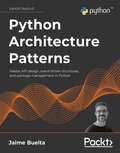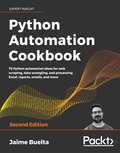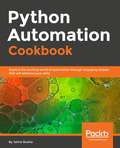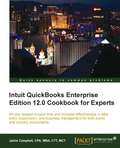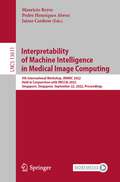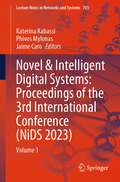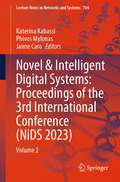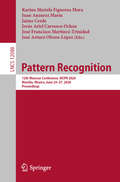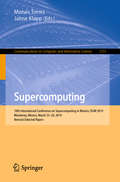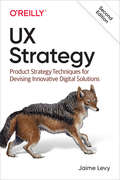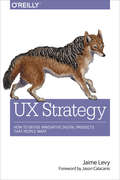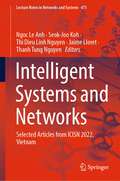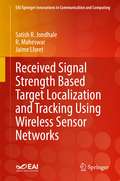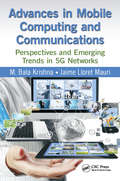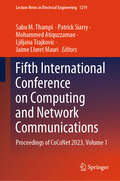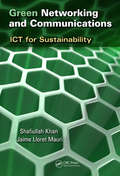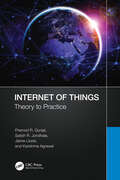- Table View
- List View
Artificial Intelligence Security and Privacy: First International Conference on Artificial Intelligence Security and Privacy, AIS&P 2023, Guangzhou, China, December 3–5, 2023, Proceedings, Part II (Lecture Notes in Computer Science #14510)
by Jin Li Moncef Gabbouj Jaideep VaidyaThis two-volume set LNCS 14509-14510, constitutes the refereed proceedings of the First International Conference on Artificial Intelligence Security and Privacy, AIS&P 2023, held in Guangzhou, China, during December 3–5, 2023.The 40 regular papers and 23 workshop papers presented in this two-volume set were carefully reviewed and selected from 115 submissions. Topics of interest include, e.g., attacks and defence on AI systems; adversarial learning; privacy-preserving data mining; differential privacy; trustworthy AI; AI fairness; AI interpretability; cryptography for AI; security applications.
Cyberspace Safety and Security: 11th International Symposium, CSS 2019, Guangzhou, China, December 1–3, 2019, Proceedings, Part I (Lecture Notes in Computer Science #11982)
by Jin Li Jaideep Vaidya Xiao ZhangThe two volumes LNCS 11982 and 11983 constitute the proceedings of the 11th International Symposium on Cyberspace Safety and Security, CSS 2019, held in Guangzhou, China, in December 2019.The 61 full papers and 40 short papers presented were carefully reviewed and selected from 235 submissions. The papers cover a broad range of topics in the field of cyberspace safety and security, such as authentication, access control, availability, integrity, privacy, confidentiality, dependability and sustainability issues of cyberspace. They are organized in the following topical sections: network security; system security; information security; privacy preservation; machine learning and security; cyberspace safety; big data and security; and cloud and security;
Cyberspace Safety and Security: 11th International Symposium, CSS 2019, Guangzhou, China, December 1–3, 2019, Proceedings, Part II (Lecture Notes in Computer Science #11983)
by Jin Li Jaideep Vaidya Xiao ZhangThe two volumes LNCS 11982 and 11983 constitute the proceedings of the 11th International Symposium on Cyberspace Safety and Security, CSS 2019, held in Guangzhou, China, in December 2019.The 61 full papers and 40 short papers presented were carefully reviewed and selected from 235 submissions. The papers cover a broad range of topics in the field of cyberspace safety and security, such as authentication, access control, availability, integrity, privacy, confidentiality, dependability and sustainability issues of cyberspace. They are organized in the following topical sections: network security; system security; information security; privacy preservation; machine learning and security; cyberspace safety; big data and security; and cloud and security;
Information Systems Security
by Rudrapatna K. Shyamasundar Virendra Singh Jaideep VaidyaThis book constitutes the refereed proceedings of the 13th International Conference on Information Systems Security, ICISS 2017, held in Mumbai, India, in December 2017. The 17 revised full papers and 7 short papers presented together with 2 invited papers were carefully reviewed and selected from 73 submissions. The papers address the following topics: privacy/cryptography, systems security, security analysis, identity management and access control, security attacks and detection, network security.
Numerical Simulation of the Aerodynamics of High-Lift Configurations
by Omar Darío López Mejia Jaime A. Escobar GomezThis book deals with numerical simulations and computations of the turbulent flow around high-lift configurations commonly used in aircraft. It is devoted to the Computational Fluids Dynamics (CFD) method using full Navier-Stokes solvers typically used in the simulation of high-lift configuration. With the increase of computational resources in the aeronautical industry, the computation of complex flows such as the aerodynamics of high-lift configurations has become an active field not only in academic but also in industrial environments. The scope of the book includes applications and topics of interest related to the simulation of high-lift configurations such as: lift and drag prediction, unsteady aerodynamics, low Reynolds effects, high performance computing, turbulence modelling, flow feature visualization, among others. This book gives a description of the state-of-the-art of computational models for simulation of high-lift configurations. It also shows and discusses numerical results and validation of these computational models. Finally, this book is a good reference for graduate students and researchers interested in the field of simulation of high-lift configurations.
Internet para todos
by Jaime A. Restrepo"Con Internet para todos, dar el primer paso para adentrarse en el mundo de las computadoras no es mas difícil que aprender a montar en bicicleta. Una vez que usted pierda el temor inicial a usarlo, el maravilloso universo del Internet estará a su alcance. " --Enrique Gonzales, Director, Hispanic Online (www. hisp. com) Usando este libro aprenderá todo lo necesario para usar el Internet: Cómo usar los navegadores Cómo usar el correo electrónico Cómo crear una página personal o "home page" Cómo bajar programas del Internet a su disco duro Con ilustraciones detalladas, un glosario de terminología de computadoras, y una lista de lugares del Web para hispanoparlantes, este as el úníco libro que usted necesitará. Deje que, con ilustraciones pormenorizadas, sea su guía mientras explora esta maravillosa tecnología llamada el Internet.
English for IT Communication (Routledge Applied English Language Introductions)
by Tony Myers Jaime BuchananEnglish for IT Communication provides a comprehensive introduction for students and professionals studying IT or computer science and covers all forms of technical communication from emails and memos through procedures to reports and design specs. In each case, the book offers multiple real-world examples, looking at who the texts are written for, what their purpose is, and how these affect what is on the page.Key features of this book include● How to write for different audiences and purposes● How to design documents for ease of access and understanding● How to communicate in multimodal media● How to reference in IEEE● Multiple different examples and breakdowns of common text types to show how they are written and to produce an understanding of quality in each● Online support material including authentic examples of different workplace genres and a reference section covering relevant research studies and weblinks for readers to better understand the topics covered in each chapter● Internationalized coverage of IT communication exemplarsThis book is an accessible guide to writing effective forms of IT communications of the kind needed for all IT degree programs which aim to prepare students for the modern workplace. Practical and clearly written, it is designed to introduce readers to features of the most common genres in IT and computer science.
Hands-On Docker for Microservices with Python: Design, deploy, and operate a complex system with multiple microservices using Docker and Kubernetes
by Jaime BueltaA step-by-step guide to building microservices using Python and Docker, along with managing and orchestrating them with Kubernetes Key Features Learn to use Docker containers to create, operate, and deploy your microservices Create workflows to manage independent deployments on coordinating services using CI and GitOps through GitHub, Travis CI, and Flux Develop a REST microservice in Python using the Flask framework and Postgres database Book Description Microservices architecture helps create complex systems with multiple, interconnected services that can be maintained by independent teams working in parallel. This book guides you on how to develop these complex systems with the help of containers. You'll start by learning to design an efficient strategy for migrating a legacy monolithic system to microservices. You'll build a RESTful microservice with Python and learn how to encapsulate the code for the services into a container using Docker. While developing the services, you'll understand how to use tools such as GitHub and Travis CI to ensure continuous delivery (CD) and continuous integration (CI). As the systems become complex and grow in size, you'll be introduced to Kubernetes and explore how to orchestrate a system of containers while managing multiple services. Next, you'll configure Kubernetes clusters for production-ready environments and secure them for reliable deployments. In the concluding chapters, you'll learn how to detect and debug critical problems with the help of logs and metrics. Finally, you'll discover a variety of strategies for working with multiple teams dealing with different microservices for effective collaboration. By the end of this book, you'll be able to build production-grade microservices as well as orchestrate a complex system of services using containers. What you will learn Discover how to design, test, and operate scalable microservices Coordinate and deploy different services using Kubernetes Use Docker to construct scalable and manageable applications with microservices Understand how to monitor a complete system to ensure early detection of problems Become well versed with migrating from an existing monolithic system to a microservice one Use load balancing to ensure seamless operation between the old monolith and the new service Who this book is for This book is for developers, engineers, or software architects who are trying to move away from traditional approaches for building complex multi-service systems by adopting microservices and containers. Although familiarity with Python programming is assumed, no prior knowledge of Docker is required.
Python Architecture Patterns: Master API design, event-driven structures, and package management in Python
by Jaime BueltaMake the best of your test suites by using cutting-edge software architecture patterns in PythonKey FeaturesLearn how to create scalable and maintainable applicationsBuild a web system for micro messaging using concepts in the bookUse profiling to find bottlenecks and improve the speed of the systemBook DescriptionDeveloping large-scale systems that continuously grow in scale and complexity requires a thorough understanding of how software projects should be implemented. Software developers, architects, and technical management teams rely on high-level software design patterns such as microservices architecture, event-driven architecture, and the strategic patterns prescribed by domain-driven design (DDD) to make their work easier. This book covers these proven architecture design patterns with a forward-looking approach to help Python developers manage application complexity—and get the most value out of their test suites. Starting with the initial stages of design, you will learn about the main blocks and mental flow to use at the start of a project. The book covers various architectural patterns like microservices, web services, and event-driven structures and how to choose the one best suited to your project. Establishing a foundation of required concepts, you will progress into development, debugging, and testing to produce high-quality code that is ready for deployment. You will learn about ongoing operations on how to continue the task after the system is deployed to end users, as the software development lifecycle is never finished. By the end of this Python book, you will have developed "architectural thinking": a different way of approaching software design, including making changes to ongoing systems.What you will learnThink like an architect, analyzing software architecture patternsExplore API design, data storage, and data representation methodsInvestigate the nuances of common architectural structuresUtilize and interoperate elements of patterns such as microservicesImplement test-driven development to perform quality code testingRecognize chunks of code that can be restructured as packagesMaintain backward compatibility and deploy iterative changesWho this book is forThis book will help software developers and architects understand the structure of large complex systems and adopt architectural patterns that are scalable. Examples in the book are implemented in Python so a fair grasp of basic Python concepts is expected. Proficiency in any programming languages such as Java or JavaScript is sufficient.
Python Automation Cookbook: 75 Python automation ideas for web scraping, data wrangling, and processing Excel, reports, emails, and more, 2nd Edition
by Jaime BueltaGet a firm grip on the core processes including browser automation, web scraping, Word, Excel, and GUI automation with Python 3.8 and higher Key Features Automate integral business processes such as report generation, email marketing, and lead generation Explore automated code testing and Python's growth in data science and AI automation in three new chapters Understand techniques to extract information and generate appealing graphs, and reports with Matplotlib Book Description In this updated and extended version of Python Automation Cookbook, each chapter now comprises the newest recipes and is revised to align with Python 3.8 and higher. The book includes three new chapters that focus on using Python for test automation, machine learning projects, and for working with messy data. This edition will enable you to develop a sharp understanding of the fundamentals required to automate business processes through real-world tasks, such as developing your first web scraping application, analyzing information to generate spreadsheet reports with graphs, and communicating with automatically generated emails. Once you grasp the basics, you will acquire the practical knowledge to create stunning graphs and charts using Matplotlib, generate rich graphics with relevant information, automate marketing campaigns, build machine learning projects, and execute debugging techniques. By the end of this book, you will be proficient in identifying monotonous tasks and resolving process inefficiencies to produce superior and reliable systems. What you will learn Learn data wrangling with Python and Pandas for your data science and AI projects Automate tasks such as text classification, email filtering, and web scraping with Python Use Matplotlib to generate a variety of stunning graphs, charts, and maps Automate a range of report generation tasks, from sending SMS and email campaigns to creating templates, adding images in Word, and even encrypting PDFs Master web scraping and web crawling of popular file formats and directories with tools like Beautiful Soup Build cool projects such as a Telegram bot for your marketing campaign, a reader from a news RSS feed, and a machine learning model to classify emails to the correct department based on their content Create fire-and-forget automation tasks by writing cron jobs, log files, and regexes with Python scripting Who this book is for Python Automation Cookbook - Second Edition is for developers, data enthusiasts or anyone who wants to automate monotonous manual tasks related to business processes such as finance, sales, and HR, among others. Working knowledge of Python is all you need to get started with this book.
Python Automation Cookbook: Explore the world of automation using Python recipes that will enhance your skills
by Jaime BueltaStep-by-step instructions which take you through each program to automate monotonous tasks with Python 3.7Key FeaturesAutomate integral business processes such as report generation, email marketing, and lead generationBuild your first web application that scrapes data and accesses websites' APIsCreate graphic-rich charts, graphs, and maps using MatplotlibBook DescriptionHave you been doing the same old monotonous office work over and over again? Or have you been trying to find an easy way to make your life better by automating some of your repetitive tasks? Through a tried and tested approach, understand how to automate all the boring stuff using Python. The Python Automation Cookbook helps you develop a clear understanding of how to automate your business processes using Python, including detecting opportunities by scraping the web, analyzing information to generate automatic spreadsheets reports with graphs, and communicating with automatically generated emails. You’ll learn how to get notifications via text messages and run tasks while your mind is focused on other important activities, followed by understanding how to scan documents such as résumés. Once you’ve gotten familiar with the fundamentals, you’ll be introduced to the world of graphs, along with studying how to produce organized charts using Matplotlib. In addition to this, you’ll gain in-depth knowledge of how to generate rich graphics showing relevant information. By the end of this book, you’ll have refined your skills by attaining a sound understanding of how to identify and correct problems to produce superior and reliable systems.What you will learnGet to grips with scraping a website to detect changesSearch and process raw sales files to aggregate information in spreadsheetsExplore techniques to extract information from an Excel spreadsheet and generate exciting reports with graphsDiscover the techniques required to generate random, print-friendly codes to be used as single-use couponsAutomatically generate a marketing campaign, contacting the recipients over different channelsIdentify and implement precise solutionsWho this book is forThe Python Automation Cookbook is for you if you are a developer or anyone who wants to automate monotonous manual tasks related to fields such as finance, sales, and HR, among others.
Intuit QuickBooks Enterprise Edition 12.0 Cookbook for Experts
by Jaime CampbellQuickBooks Enterprise Edition 12.0 Cookbook for Experts is written in a non-sequential, modular way which enables the reader to select any relevant and valuable technique and learn it. Each recipe in the cookbook includes illustrations to make the most difficult techniques straightforward. Furthermore, the expert reader's time is not wasted on any basic language and steps. This book is written for CPAs, consultants, CFOs, controllers, managers, or bookkeepers with extensive experience with QuickBooks. Prior experience with the Enterprise Edition, however, is not required. You should have a thorough understanding of accounting procedures and a mastery of the basics of the QuickBooks environment.
Interpretability of Machine Intelligence in Medical Image Computing: 5th International Workshop, iMIMIC 2022, Held in Conjunction with MICCAI 2022, Singapore, Singapore, September 22, 2022, Proceedings (Lecture Notes in Computer Science #13611)
by Jaime Cardoso Mauricio Reyes Pedro Henriques AbreuThis book constitutes the refereed joint proceedings of the 5th International Workshop on Interpretability of Machine Intelligence in Medical Image Computing, iMIMIC 2022, held in September 2022, in conjunction with the 25th International Conference on Medical Imaging and Computer-Assisted Intervention, MICCAI 2022.The 10 full papers presented at iMIMIC 2022 were carefully reviewed and selected from 24 submissions each. The iMIMIC papers focus on introducing the challenges and opportunities related to the topic of interpretability of machine learning systems in the context of medical imaging and computer assisted intervention.
Novel & Intelligent Digital Systems: Volume 1 (Lecture Notes in Networks and Systems #783)
by Phivos Mylonas Jaime Caro Katerina KabassiThis book summarizes the research findings presented at the 3rd International Conference on Novel & Intelligent Digital Systems (NiDS 2023). NiDS 2023 held in Athens, Greece, during September 28–29, 2023, under the auspices of the Institute of Intelligent Systems. The conference was implemented hybrid, allowing participants to attend it either online or onsite. NiDS 2023 places significant importance on the innovations within intelligent systems and the collaborative research that empowers and enriches artificial intelligence (AI) in software development. It encourages high-quality research, establishing a forum for investigating the obstacles and cutting-edge breakthroughs in AI. The conference is designed for experts, researchers, and scholars in artificial and computational intelligence, as well as computer science in general, offering them the opportunity to delve into relevant, interconnected, and mutually complementary fields. By facilitating the exchange of ideas, the conference strengthens and broadens the network of researchers, academics, and industry representatives.
Novel & Intelligent Digital Systems: Volume 2 (Lecture Notes in Networks and Systems #784)
by Phivos Mylonas Jaime Caro Katerina KabassiThis book summarizes the research findings presented at the 3rd International Conference on Novel & Intelligent Digital Systems (NiDS 2023). NiDS 2023 held in Athens, Greece, during September 28–29, 2023, under the auspices of the Institute of Intelligent Systems. The conference was implemented hybrid, allowing participants to attend it either online or onsite. NiDS 2023 places significant importance on the innovations within intelligent systems and the collaborative research that empowers and enriches artificial intelligence (AI) in software development. It encourages high-quality research, establishing a forum for investigating the obstacles and cutting-edge breakthroughs in AI. The conference is designed for experts, researchers, and scholars in artificial and computational intelligence, as well as computer science in general, offering them the opportunity to delve into relevant, interconnected, and mutually complementary fields. By facilitating the exchange of ideas, the conference strengthens and broadens the network of researchers, academics, and industry representatives.
Pattern Recognition: 12th Mexican Conference, MCPR 2020, Morelia, Mexico, June 24–27, 2020, Proceedings (Lecture Notes in Computer Science #12088)
by Jesús Ariel Carrasco-Ochoa José Francisco Martínez-Trinidad José Arturo Olvera-López Karina Mariela Figueroa Mora Juan Anzurez Marín Jaime CerdaThis book constitutes the proceedings of the 12th Mexican Conference on Pattern Recognition, MCPR 2020, which was due to be held in Morelia, Mexico, in June 2020. The conference was held virtually due to the COVID-19 pandemic.The 31 papers presented in this volume were carefully reviewed and selected from 67 submissions. They were organized in the following topical sections: pattern recognition techniques; image processing and analysis; computer vision; industrial and medical applications of pattern recognition; natural language processing and recognition; artificial intelligence techniques and recognition.
Supercomputing: 10th International Conference on Supercomputing in Mexico, ISUM 2019, Monterrey, Mexico, March 25–29, 2019, Revised Selected Papers (Communications in Computer and Information Science #1151)
by Jaime Klapp Moisés TorresThis book constitutes the refereed proceedings of the 10th International Conference on Supercomputing, ISUM 2019, held in Monterrey, Mexico, in March 2019.The 25 revised full papers presented were carefully reviewed and selected from 78 submissions. The papers are organized in topical sections on HPC architecture, networks, system software, algorithmic techniques, modeling and system tools, clouds, distributed computing, big data, data analytics, visualization and storage, applications for science and engineering, and emer- ging technologies.
UX Strategy: How To Devise Innovative Digital Products That People Want
by Jaime LevyUser experience (UX) strategy lies at the intersection of UX design and business strategy, but until now, there hasn't been an easy-to-apply framework for executing it. This hands-on guide introduces lightweight product strategy tools and techniques to help you and your team devise innovative digital solutions that people want.Author Jaime Levy shows UX/UI designers, product managers, entrepreneurs, and aspiring strategists simple to advanced methods that can be applied right away. You'll gain valuable perspective through business cases and historical context. This second edition includes new real-world examples, updated techniques, and a chapter on conducting qualitative online user research.Define value propositions and validate target users through provisional personas and customer discovery techniquesExplore marketplace opportunities by conducting competitive research and analysisDesign experiments using rapid prototypes that are focused on the business modelConduct online user research to gain valuable insights quickly on any budgetTest business ideas and validate marketing channels by running online advertising and landing page campaigns
UX Strategy: How to Devise Innovative Digital Products that People Want
by Jaime LevyUser experience (UX) strategy requires a careful blend of business strategy and UX design, but until now, there hasn't been an easy-to-apply framework for executing it. This hands-on guide introduces lightweight strategy tools and techniques to help you and your team craft innovative multi-device products that people like to use.Whether you're an entrepreneur, UX/UI designer, product manager, or part of an intrapreneurial team, this book teaches simple-to-advanced strategies that you can use in your work right away. Along with business cases, historical context, and real-world examples throughout, you'll also gain different perspectives on the subject through interviews with top strategists.Define and validate your target users through provisional personas and customer discovery techniquesConduct competitive research and analysis to explore a crowded marketplace or an opportunity to create unique valueFocus your team on the primary utility and business model of your product by running structured experiments using prototypesDevise UX funnels that increase customer engagement by mapping desired user actions to meaningful metrics
Intelligent Systems and Networks: Selected Articles from ICISN 2022, Vietnam (Lecture Notes in Networks and Systems #471)
by Jaime Lloret Thi Dieu Linh Nguyen Ngoc Le Anh Seok-Joo Koh Thanh Tung NguyenThis book presents Proceedings of the International Conference on Intelligent Systems and Networks (ICISN 2022), held at Hanoi in Vietnam. It includes peer reviewed high quality articles on Intelligent System and Networks. It brings together professionals and researchers in the area and presents a platform for exchange of ideas and to foster future collaboration. The topics covered in this book include- Foundations of Computer Science; Computational Intelligence Language and speech processing; Software Engineering Software development methods; Wireless Communications Signal Processing for Communications; Electronics track IoT and Sensor Systems Embedded Systems; etc.
Received Signal Strength Based Target Localization and Tracking Using Wireless Sensor Networks (EAI/Springer Innovations in Communication and Computing)
by Jaime Lloret R. Maheswar Satish R. JondhaleThis book briefly summarizes the current state of the art technologies and solutions for location and tracking (L&T) in wireless sensor networks (WSN), focusing on RSS-based schemes. The authors offer broad and in-depth coverage of essential topics including range-based and range-free localization strategies, and signal path loss models. In addition, the book includes motion models and how state estimation techniques and advanced machine learning techniques can be utilized to design L&T systems for a given problem using low cost measurement metric (that is RSS). This book also provides MATLAB examples to demonstrate fundamental algorithms for L&T and provides online access to all MATLAB codes. The book allows practicing engineers and graduate students to keep pace with contemporary research and new technologies in the L&T domain.
Advances in Mobile Computing and Communications: Perspectives and Emerging Trends in 5G Networks
by M. Bala Krishna Jaime Lloret MauriBy 2020, if not before, mobile computing and wireless systems are expected to enter the fifth generation (5G), which promises evolutionary if not revolutionary services. What those advanced services will look like, sound like, and feel like is the theme of the book Advances in Mobile Computing and Communications: Perspectives and Emerging Trends in 5G Networks. The book explores futuristic and compelling ideas in latest developments of communication and networking aspects of 5G. As such, it serves as an excellent guide for advanced developers, communication network scientists, researchers, academicians, and graduate students. The authors address computing models, communication architecture, and protocols based on 3G, LTE, LTE-A, 4G, and beyond. Topics include advances in 4G, radio propagation and channel modeling aspects of 4G networks, limited feedback for 4G, and game theory application for power control and subcarrier allocation in OFDMA cellular networks. Additionally, the book covers millimeter-wave technology for 5G networks, multicellular heterogeneous networks, and energy-efficient mobile wireless network operations for 4G and beyond using HetNets. Finally, the authors delve into opportunistic multiconnect networks with P2P WiFi and cellular providers and video streaming over wireless channels for 4G and beyond.
Fifth International Conference on Computing and Network Communications: Proceedings of CoCoNet 2023, Volume 1 (Lecture Notes in Electrical Engineering #1219)
by Patrick Siarry Sabu M. Thampi Mohammed Atiquzzaman Ljiljana Trajkovic Jaime Lloret MauriThis book constitutes thoroughly refereed post-conference proceedings of the 5th International Conference on Computing and Network Communications, CoCoNet'23. The revised papers presented are carefully reviewed and selected from several initial submissions. The scope of the Symposium includes Network-on-Chip Architectures and Applications, Future Internet Architecture and Protocols, Intelligent Networked Systems, IoT and smart cities, Communications Systems Integration and Modelling, and Wireless and Mobile Communications. The book is directed to the researchers and scientists engaged in various fields of network communications.
Green Networking and Communications: ICT for Sustainability
by Jaime Lloret Mauri Shafiullah KhanAlthough the information and communication technology (ICT) industry accounted for only 2 percent of global greenhouse gas emissions in 2007, the explosive increase in data traffic brought about by a rapidly growing user base of more than a billion wireless subscribers is expected to nearly double that number by 2020. It is clear that now is the ti
Internet of Things: Theory to Practice
by Jaime Lloret Mauri Satish R. Jondhale Pramod R. Gunjal Karishma AgrawalThis book addresses the fundamental technologies, architectures, application domains, and future research directions of the Internet of Things (IoT). It also discusses how to create your own IoT system according to applications requirements, and it presents a broader view of recent trends in the IoT domain and open research issues. This book encompasses various research areas such as wireless networking, advanced signal processing, IoT, and ubiquitous computing. Internet of Things: Theory to Practice discusses the basics and fundamentals of IoT and real-time applications, as well as the associated challenges and open research issues. The book includes several case studies about the use of IoT in day-to-day life. The authors review various advanced computing technologies—such as cloud computing, fog computing, edge computing, and Big Data analytics—that will play crucial roles in future IoT-based services. The book provides a detailed role of blockchain technology, Narrowband IoT (NB-IoT), wireless body area network (WBAN), LoRa (a longrange low power platform), and Industrial IoT (IIoT) in the 5G world. This book is intended for university/college students, as well as amateur electronic hobbyists and industry professionals who are looking to stay current in the IoT domain.
